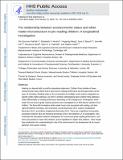| dc.contributor.author | Ozernov-Palchik, Ola | |
| dc.contributor.author | Norton, Elizabeth S. | |
| dc.contributor.author | Wang, Yingying | |
| dc.contributor.author | Beach, Sara Dawley | |
| dc.contributor.author | Zuk, Jennifer | |
| dc.contributor.author | Wolf, Maryanne | |
| dc.contributor.author | Gabrieli, John D. E. | |
| dc.contributor.author | Gaab, Nadine | |
| dc.date.accessioned | 2020-08-17T17:58:51Z | |
| dc.date.available | 2020-08-17T17:58:51Z | |
| dc.date.issued | 2018-10 | |
| dc.date.submitted | 2018-09 | |
| dc.identifier.issn | 1065-9471 | |
| dc.identifier.issn | 1097-0193 | |
| dc.identifier.uri | https://hdl.handle.net/1721.1/126628 | |
| dc.description.abstract | Reading is a learned skill crucial for educational attainment. Children from families of lower socioeconomic status (SES) tend to have poorer reading performance and this gap widens across years of schooling. Reading relies on the orchestration of multiple neural systems integrated via specific white-matter pathways, but there is limited understanding about whether these pathways relate differentially to reading performance depending on SES background. Kindergarten white-matter FA and second-grade reading outcomes were investigated in an SES-diverse sample of 125 children. The three left-hemisphere white-matter tracts most associated with reading, and their right-hemisphere homologs, were examined: arcuate fasciculus (AF), superior longitudinal fasciculus (SLF), and inferior longitudinal fasciculus (ILF). There was a significant and positive association between SES and fractional anisotropy (FA) in the bilateral ILF in kindergarten. SES moderated the association between kindergarten ILF and second grade reading performance, such that it was positive in lower-SES children, but not significant in higher-SES children. These results have implications for understanding the role of the environment in the development of the neural pathways that support reading. | en_US |
| dc.description.sponsorship | National Institutes of Health (Grant R01HD067312) | en_US |
| dc.description.sponsorship | National Institute of Child Health and Human Development (Grant R01HD067312) | en_US |
| dc.language.iso | en | |
| dc.publisher | Wiley | en_US |
| dc.relation.isversionof | http://dx.doi.org/10.1002/hbm.24407 | en_US |
| dc.rights | Creative Commons Attribution-Noncommercial-Share Alike | en_US |
| dc.rights.uri | http://creativecommons.org/licenses/by-nc-sa/4.0/ | en_US |
| dc.source | PMC | en_US |
| dc.title | The relationship between socioeconomic status and white matter microstructure in pre‐reading children: A longitudinal investigation | en_US |
| dc.type | Article | en_US |
| dc.identifier.citation | Ozernov-Palchik, Ola et al. "The relationship between socioeconomic status and white matter microstructure in pre‐reading children: A longitudinal investigation." Human Brain Mapping 40, 3 (October 2018): 741-754 © 2018 Wiley Periodicals, Inc | en_US |
| dc.contributor.department | Massachusetts Institute of Technology. Department of Brain and Cognitive Sciences | en_US |
| dc.contributor.department | McGovern Institute for Brain Research at MIT | en_US |
| dc.relation.journal | Human Brain Mapping | en_US |
| dc.eprint.version | Author's final manuscript | en_US |
| dc.type.uri | http://purl.org/eprint/type/JournalArticle | en_US |
| eprint.status | http://purl.org/eprint/status/PeerReviewed | en_US |
| dc.date.updated | 2019-10-01T14:34:41Z | |
| dspace.date.submission | 2019-10-01T14:34:43Z | |
| mit.journal.volume | 40 | en_US |
| mit.journal.issue | 3 | en_US |
| mit.metadata.status | Complete | |
